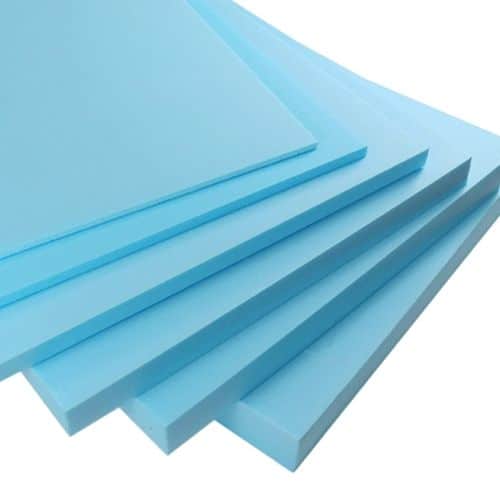Properties of XPS Insulation
Extruded polystyrene, abbreviated as XPS, is a form of rigid thermoplastic insulation made from polystyrene. Essentially, polystyrene is a form of synthetic polymer made from ethylene and benzene.
XPS foam is typically used for insulation on roofs, walls, attics, and ceilings to minimize thermal transfer and enhance energy efficiency. It’s also used in basements and foundations. Let’s discuss its properties in detail.

Thermal Resistance
Different insulation materials have different thermal properties. Generally, an insulation material works by resisting heat transfer. A material’s effectiveness in resisting heat transfer is measured in R-value.
A higher R-value shows that the material is more effective in resisting heat transfer, thereby making it a better insulation material.
XPS features a closed-cell structure that’s uniformly distributed to assist in achieving a high R-value rated at R-5 for every inch. Research shows that XPS has twice the thermal resistance of most insulation materials of similar thickness.
XPS foam is manufactured using a continuous extrusion mechanism that produces a closed-cell structure. Each cell is completely enclosed with polystyrene without leaving any voids. As a result, the foam retains reliable and uniform thermal performance for a long time regardless of the material’s density.
However, the cells contain blowing agents or insulating gases that diffuse out with time in a process known as aging. As it ages, the insulation value may degrade over time, thereby reducing its thermal resistance.
Due to its superb thermal properties, XPS is suitable for use as insulation in residential and commercial properties. In fact, installing XPS in an older home can increase its energy efficiency by as much as 70 percent.
Moisture Resistance Properties
The moisture resistance of any material is represented in perm rating. The lower the perm rating, the higher the moisture resistance of a material. High moisture resistance is important since water conducts heat.
XPS foam only allows a little amount of water to pass through. Thus, it offers reliable thermal resistance. Generally, XPS foam offers sufficient water resistance properties that make it resist normal moisture levels in the foundation and basement. However, it’s not ideal for use in homes built in flood plains.
An unfaced XPS foam with a thickness of 1 inch has a moisture resistance rating of approximately 1.0. However, the effectiveness of a material in insulation is not just resisting moisture but also how readily it releases any absorbed moisture. The process of releasing absorbed moisture is known as drying potential.
Insulation material needs to have dry quickly for enhanced thermal resistance. Research shows that XPS foam retains any absorbed moisture for a longer period than expanded polystyrene (EPS) insulation.
Thus, the potential of XPS in retaining moisture degrades its R-value over time, thereby lowering its insulation potential.
Compressive Strength
Research shows that XPS foam has superb compressive strength. Its closed-cell structure, lack of spaces, and fully enclosed cells add to its superb compressive strength.
Different XPS products have different compressive strengths. The compressive strength rating to choose depends on the application. XPS foam has a compressive strength of 100 psi at most.
Durability
Since XPS is a form of thermoplastic insulation material, it doesn’t decompose or rot over time. Also, it resists soil microorganisms. Also, it doesn’t attract rats. Its lifespan is about 50 years at most.
Dimensional Stability
XPS foam tends to expand and warp at high temperatures. Thus, it’s not suitable for use on surfaces that are exposed to extreme heat.
Inhibiting Growth of Air Contaminants
Essentially, the presence of moisture encourages many organisms like fungi, mildew, bacteria, and mold to thrive. XPS foam is moisture resistant. Thus, it inhibits these organisms from growing.
If they thrive on a surface, they can contaminate the air and cause health issues.
Chemical Inertness
Fortunately, XPS is a fairly inert insulation material. It resists most aqueous solutions comprising alkalis and salts, bases, and acids.
However, it can be attacked and dissolved by several organic solvents like acetone, aromatic hydrocarbon, and chlorinated solvents.
Cost
Extruded polystyrene is among the most economic rigid foams available today. It’s a great option for someone working with a tight budget.
Density and Size
XPS is manufactured as either unfaced or with plastic facings. However, the process of manufacturing EPS is limited such that it’s only available in standard sizes and in the form of sheets.
The sheets have a standard size of 4 by 8 feet. XPS is very dense. It weighs about 2.18 pounds for every cubic foot. Its high density makes it highly durable.
Energy Efficiency
Extruded polystyrene is highly energy efficient. It saves a lot more energy than the amount of energy used during its manufacturing process. It saves energy throughout its lifespan.
Sustainability
Insulating walls with XPS is proven to minimize the energy needed to cool or heat a home. Thus, it reduces energy consumption. Consequently, it’s a sustainable material. Since it comprises polystyrene, the material can be recycled to make new XPS foams.
Related:
